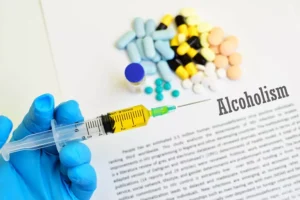Alaskans are increasingly abusing multiple drugs, complicating treatment
- Posted on
- wadminw

But instead of motivating you to do the things you need to do to survive (eat, work and spend time with loved ones), such massive dopamine levels can have damaging effects on your thoughts, feelings and behavior. As a person continues to use drugs, the brain adapts by reducing the ability of cells in the reward circuit to respond to it. This reduces the high that the person feels compared to the high they felt when first taking the drug—an effect known as tolerance. They might take more of the drug to try and achieve the same high. These brain adaptations often lead to the person becoming less and less able to derive pleasure from other things they once enjoyed, like food, sex, or social activities.
- Figure 1 presents a schematic model of associations that have been supported in research, as well as remaining gaps.
- These other mental health disorders can include anxiety disorders, depression, attention-deficit hyperactivity disorder (ADHD), bipolar disorder, personality disorders, and schizophrenia, among others.
- Treatment for drug addiction may involve psychotherapy, medication, hospitalization, support groups, or a combination.
- For certain drug types, some symptoms are less prominent, and in some cases, not all symptoms apply.
- Children exposed to drugs before birth may go on to develop issues with behavior, attention, and thinking.
- Recently, Caprioli et al. 133 extensively reviewed preclinical studies on allosteric modulators of mGluRs on animal models of drug addiction and their potential translational implications.
Substance Use Disorder vs. Substance Abuse
The drugs that may be addictive target your brain’s reward system. When you use opioids for pain for a long time, for example, you may develop tolerance and even physical dependence. In general, when narcotics are used under proper medical supervision, addiction happens in only a small percentage of people. Addictive substances and behaviors can create a pleasurable “high” that’s physical and psychological. You’ll typically use more of certain substances or engage in behaviors longer to achieve the same high again. An addiction is a chronic dysfunction of the brain system that involves reward, motivation, and memory.
Help for Mental Illnesses
After discussion with you, your health care provider may recommend medicine as part of your treatment for opioid addiction. Medicines don’t cure your opioid addiction, but they can help in your recovery. These medicines can reduce your craving for opioids and may help you avoid relapse. Medicine treatment options for opioid addiction may include buprenorphine, methadone, naltrexone, and a combination of buprenorphine and naloxone.
Overdose Deaths in the United States

The Hustle Gang rappers were recently in NYC on “The Breakfast Club” to discuss what is drug addiction their musical future and recent $71 million OMG Girlz lawsuit win … Forcing him to check himself into rehab in order to save his life. He recalled other times he took combinations of drugs or times he didn’t know exactly what he was taking. Dorwart has a Ph.D. from UC San Diego and is a health journalist interested in mental health, pregnancy, and disability rights. This leads people to compulsively use drugs in search of another euphoric “high.” The consequences of these neurological changes can be either temporary or permanent.
If taking drugs makes people feel good or better, what’s the problem?

Information about NIMH, research results, summaries of scientific meetings, and mental health resources. The latest information and resources on mental disorders shared on X, Facebook, YouTube, LinkedIn, and Instagram. The Division of Intramural Research Programs https://ecosoberhouse.com/article/choosing-sobriety-gifts-10-great-ideas-to-consider/ (IRP) is the internal research division of the NIMH. Over 40 research groups conduct basic neuroscience research and clinical investigations of mental illnesses, brain function, and behavior at the NIH campus in Bethesda, Maryland. Download, read, and order free NIMH brochures and fact sheets about mental disorders and related topics. NIMH offers expert-reviewed information on mental disorders and a range of topics.
Linking epigenetics and synaptic plasticity

Of course, bridging epigenetic mechanisms with synaptic plasticity is not limited to drug addiction field. For example, in 2011, Monsey et al. 196 elegantly demonstrated that DNA methylation and histone H3 acetylation regulate auditory fear conditioning and its related synaptic plasticity in the amygdala. In 2014, Massart et al. 197 suggested that sleep deprivation induces epigenetic modification (alteration in DNA methylation and hydroxymethylation) that triggers synaptic plasticity modifications by changing expression of plasticity related genes. In the past, addiction was thought to only encompass substance abuse, but the definition has been expanded to include activities like gambling as well as gaming, shopping. It’s also important to note that addiction is about the underlying neurology of the brain and not about the outward behaviors. With appropriate treatment, people with addictions can go on to live happy, healthy lives.
What are the signs?

The term dual diagnosis refers to the presence of both a drug use disorder and a serious mental health problem in a person. Substance use disorders, unfortunately, occur quite commonly in people who also have a severe mental illness. Individuals with dual diagnoses are also at higher risk of being non-compliant with treatment.
- Many of the effects of drug addiction are similar, no matter what substance someone uses.
- Nowadays, these two subfields are mostly studied separately and the understanding of how these two main addictive drug-induced brain modifications interact might be fundamental for addiction research 6.
- While histone acetylation and methylation are increasingly studied, an important field of future investigation will be to understand the other drug-induced histone PTMs.
- The incapability of GABAergic synapses to potentiate after morphine or cocaine administration may promote LTP of glutamatergic synapses 58, 59.
If you cannot reach a qualified professional by telephone to discuss the overdose, it would be prudent for you to take the overdosed person to the nearest hospital’s emergency department or medical facility. Your doctor, your local poison center, or the emergency department of your local hospital may be able to help determine the seriousness of a suspected drug overdose. After a drug overdose, you’ll need immediate and accurate information about the specific name of the drug, the amount of the drug ingested, and the time when the drug was taken. Often, the bottle the drug came in will have the information needed. If you’re depressed, have trouble paying attention, or worry constantly, you have a higher chance of addiction.
Changes in the brain
Exposure to chemicals, plants, and other toxic substances that can cause harm are called poisonings. The higher the dose or the longer the exposure, the worse the poisoning. Two examples are carbon monoxide poisoning and mushroom poisoning. Most people who take their pain medicine as directed by their doctor do not become addicted, even if they take the medicine for a long time. Fears about addiction should not prevent you from using narcotics to relieve your pain, but it’s smart to use caution. If your parents or siblings have problems with alcohol or drugs, you’re more likely as well.

